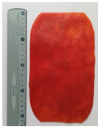Evaluation of a New Animal Tissue-Free Bleeding Model for Training of Endoscopic Hemostasis
- PMID: 37176670
- PMCID: PMC10179644
- DOI: 10.3390/jcm12093230
Evaluation of a New Animal Tissue-Free Bleeding Model for Training of Endoscopic Hemostasis
Abstract
Background: For endoscopists, knowledge of the available hemotherapeutic devices and materials as well as competence in using them is a life-saving expertise in the treatment of patients with acute gastrointestinal bleeding. These competences can be acquired in training on live animals, animal organs, or simulators. We present an animal tissue-free training model of the upper gastrointestinal tract for bleeding therapy.
Methods: An artificial, animal tissue-free mucosa and submucosa with the opportunity of injection and clipping therapy were created first. Patches with this artificial mucosa and submucosa were placed into silicone and latex organs with human-like anatomy. Esophageal bleeding situations were imitated as variceal bleeding and bleeding of a reflux esophagitis in latex organs. Finally, a modular training model with human anatomy and replaceable bleeding sources was created. Evaluation of the novel model for gastroscopic training was performed in a multicentric setting with endoscopic beginners and experts.
Results: Evaluation was carried out by 38 physicians with different levels of education in endoscopy. Evaluation of the model was made with grades from one (excellent) to six (bad): suitability for endoscopic training was 1.4, relevance of the endoscopic training was 1.6, and grading for haptic and optic impression of the model was 1.7.
Conclusions: The creation of a gastroscopic model for the training of hemostatic techniques without animal tissues was possible and multiple endoscopic bleeding skills could be trained in it. Evaluation showed good results for this new training option, which could be used in every endoscopic unit or other places without hygienic doubts.
Keywords: clipping for hemostasis; hemostasis; training endoscopy; training in endoscopic hemostasis; variceal banding.
Conflict of interest statement
The authors declare no conflict of interest.
Figures







Similar articles
-
Validation of a live animal model for training in endoscopic hemostasis of upper gastrointestinal bleeding ulcers.Endoscopy. 2013 Jun;45(6):451-7. doi: 10.1055/s-0032-1326483. Epub 2013 Jun 3. Endoscopy. 2013. PMID: 23733728
-
Endoscopic diagnosis and management of esophagogastric variceal hemorrhage: European Society of Gastrointestinal Endoscopy (ESGE) Guideline.Endoscopy. 2022 Nov;54(11):1094-1120. doi: 10.1055/a-1939-4887. Epub 2022 Sep 29. Endoscopy. 2022. PMID: 36174643
-
AGA Clinical Practice Update on Endoscopic Therapies for Non-Variceal Upper Gastrointestinal Bleeding: Expert Review.Gastroenterology. 2020 Sep;159(3):1120-1128. doi: 10.1053/j.gastro.2020.05.095. Epub 2020 Jun 20. Gastroenterology. 2020. PMID: 32574620 Review.
-
Training on an ex vivo animal model improves endoscopic skills: a randomized, single-blind study.Gastrointest Endosc. 2011 Aug;74(2):367-73. doi: 10.1016/j.gie.2011.04.042. Gastrointest Endosc. 2011. PMID: 21802589 Clinical Trial.
-
[New methods for endoscopic hemostasis: focus on non-variceal gastrointestinal bleeding].Z Gastroenterol. 2016 Mar;54(3):250-5. doi: 10.1055/s-0035-1566987. Epub 2016 Feb 19. Z Gastroenterol. 2016. PMID: 26894683 Review. German.
References
-
- Gotz M., Anders M., Biecker E., Bojarski C., Braun G., Brechmann T., Dechene A., Dollinger M., Gawaz M., Kiesslich R., et al. S2k Guideline Gastrointestinal Bleeding—Guideline of the German Society of Gastroenterology DGVS. Z. Gastroenterol. 2017;55:883–936. doi: 10.1055/s-0043-116856. - DOI - PubMed
Grants and funding
LinkOut - more resources
Full Text Sources
Research Materials

